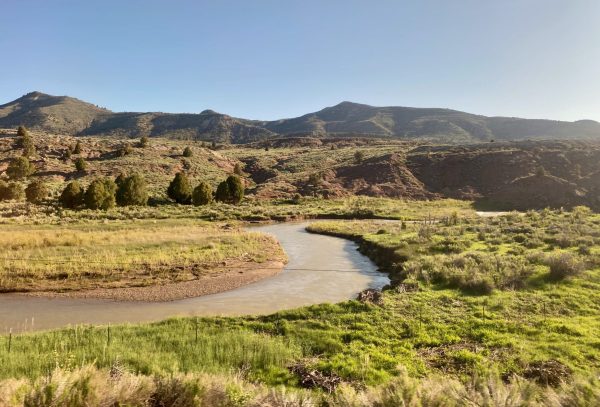Utah oil loading facility ‘out of compliance’ with state air-quality regs but still seeking federal OK

The Price River near Kyune, Utah, where the proposed Uinta Basin Railway would meet the existing Union Pacific line, is pictured from an Amtrak passenger train on June 5, 2023. (Chase Woodruff/Colorado Newsline)
A privately owned oil loading facility on public lands eight miles northwest of Price, Utah, has been operating out of compliance with state air-quality regulations for years, a state official recently confirmed to Colorado Newsline, and likely will continue to do so as it seeks approval from the federal government for a massive expansion to serve the booming, nearby Uinta Basin.
The Wildcat Loadout near Price, located on U.S. Bureau of Land Management land, was originally just a coal-loading facility where trucks transferred coal onto trains on Union Pacific’s Central Corridor rail line, which heads west to Nevada and east to Colorado. In recent years, the Wildcat Loadout has also been used to transfer oil from the Uinta Basin from trucks onto trains.
Expanding the Wildcat Loadout from its current level of 30,000 barrels of waxy Uinta Basin crude oil a day to a capacity of 100,000 barrels a day requires both the approval of the BLM and a modified air-quality permit from the Utah Department of Environmental Quality. The expansion is viewed by opponents as a Plan B in the event the proposed Uinta Basin Railway is blocked.
Rik Ombach, manager of oil and gas compliance for Utah’s Division of Air Quality, told Newsline in a phone interview that the state did conduct an advisory inspection at the facility in March 2022 and found violations, although no fines have been levied and no steps have been taken to remedy the situation.
“So, we did write an advisory for them, and we did quite a bit of I guess research and meetings and discussions and recently we did write a no further action letter for that site. Now, technically, if you get really technical, they’re out of compliance. If you look at it just for the intent, then they’re operating within their requirements,” Ombach said. “That’s kind of confusing.”
The division’s 2022 advisory reads: “The Facility is operating without air pollution control equipment and not a manner consistent with good air pollution control practice for minimizing emissions. The Facility has been operating in this manner since December of 2019.”
The advisory also found that holding tanks and a combustor/flare weren’t installed to reduce pollution from volatile organic compounds, of VOCs, that cause smog, and that the facility owner didn’t notify the state in writing.
“They have a permit with us, and there’s been some ownership changes, transfers and so forth. There’s at a minimum a name change,” Ombach explained. “And so the facility did not get built at all according to what their initial permit says. So, when the group bought it, they said, ‘We are going to operate it below the permit’s requirements, and then we will modify the permit rather than just totally canceling the permit and then starting all over and getting a new permit.’”
Ombach went on to say the lack of flaring at the loadout facility is being handled by “vapor balancing,” which involves an oil truck hooking up a bottom hose to deliver the oil into a railroad tanker and a top hose to collect the ensuing vapors. Uinta Basin waxy crude is prized for its low sulfur and high paraffin content, but that means it can’t be moved in a pipeline and must be transferred in insulated and heated trucks and rail cars to avoid solidifying.
“They were going to build tanks and such, as well, so they haven’t built the holding facilities there that would require the flaring,” Ombach acknowledged. “And so, right now, they said in order to keep the VOCs within the limit to get a permit, they are just doing the typical, standard, what we call vapor balancing.”
‘I don’t trust them’
After a truck unloads, it heads back to get new oil in the Uinta Basin, hooks up the same way, and the vapors would then ideally be flared — that is, burned off to avoid emissions — at the wellhead instead of at the loadout location, Ombach said. Asked if there’s a chance the VOCs in the trucks are just being vented, he said yes.
Down the Line: Tracing the route — and risks — of Utah’s proposed Colorado-bound oil trains
“Well, I’m sure a lot of that is happening, and so we are inspecting them often to make sure at a minimum they are, they appear to be, doing the vapor balancing at the loadout facility there in Price,” Ombach said. “And then, of course, when we’re doing our regular inspections on the wellheads, if we see trucks that don’t use the vapor balancing when they hook up, we will cite them.”
Because of the lack of flaring of VOCs at the loadout, the state’s March 2022 inspection found “the actual emissions are approximately 40 tons of VOCs from December 2020 through November 2021.” That’s just one year of emissions, and the lack of flaring has been going on for years and could continue several more years, with the responsibility essentially shifted to the truckers.
“But we don’t see the trucks loading and unloading a lot,” Ombach admits. “I’m sure there’s more emissions, but we’re not actively pursuing all the trucks and everything like that. I’ll tell you, personally, I don’t like it, because I don’t really feel like all the trucks are being … it slows down the trucks, and so, yeah, I don’t trust them.”
Limiting public involvement
Environmental groups opposed to the Wildcat Loadout expansion say state and federal air-quality regulations have been flouted for years and that the owners aren’t being held accountable.
“Yeah, these truckers aren’t obligated to control their emissions,” said Jeremy Nichols, senior advocate for the Center for Biological Diversity — one of the groups opposed to the expansion. “It’s the company running the loading facility.”
According to records filed with the Utah oil and mining regulators this year, James Finley is a 50% owner of the Wildcat Loadout Management LLC. Finley owns Finley Resources, Inc., and is president of Uinta Wax Operating LLC, also known as CH4-Finley Operating. Those two companies are among the top oil producers in the Uinta Basin this year. Finley Resources and Uinta Wax produced a combined 9.5 million barrels of oil last year, or an average of nearly 26,000 barrels per day, according to state regulators.
Joe Shotwell, president of Wildcat Loadout Management, declined to comment for this story. “We have no comments on our side. You guys need to figure out where you get your information from,” he told a reporter.
Landon Newell, staff attorney for the Southern Utah Wilderness Alliance — another group opposing the expansion — said in a phone interview, “You could ask their legal department about their pattern and practice of avoiding the legal regulations that govern activities on lands in Utah. It’s the poster child for why the state and the federal government need to take a very close look at this proposal.”
In correspondence the alliance obtained through a public information request, a representative for Wildcat’s consulting firm, Barr Engineering, asked the BLM why it’s considering an environmental assessment for the expansion, which can take up to a year, as opposed to a no-review categorical exclusion. Then the Barr representative made an interesting request: “Wildcat Midstream and Barr requests close coordination and communication in all phases of EA development to ensure that the correct and pertinent information is documented, and public comment scrutiny is streamlined.”
“Making this all the more troubling is the fact that … the company was kind of going about it in a sneaky way, encouraging the agency to try to keep the public participation period streamlined, which is the company’s speak for limiting public involvement in the project,” said Newell, who points out his organization first flagged compliance issues at the loadout to state air-quality officials in 2014.
“This isn’t some new issue that the state just learned about,” Newell said, adding there is a longstanding pattern of Utah giving oil and gas companies a great deal of leeway and levying very few fines. “The state has very lax enforcement when it comes to penalties like this.”
Bennet requests thorough review
The number of oil trucks arriving at the loadout per day will more than double in the expansion from the current level of 100 to 214, according to correspondence, and train traffic would jump from one every two days to one a day. Those trains would head east through Colorado, along the Colorado River for about 100 miles, and through Denver on their way to Gulf Coast refineries.
For that reason, U.S. Sen. Michael Bennet of Colorado, who has led the regulatory effort against the Uinta Basin Railway, sent a letter to BLM Director Tracy Stone-Manning requesting a full-blown environmental impact statement for the expansion — a process that could take an additional two years to complete. Stone-Manning replied to Bennet on Nov. 8 that the Wildcat Loadout expansion proposal was incomplete, that the BLM is gathering more information and “will not take action on the project, nor can we determine the appropriate approach to comply with NEPA (National Environmental Policy Act), until the application is complete.”
In the meantime, Utah’s Ombach said the “vapor balancing” act will go on without the required flaring of VOCs: “(The owners) said they do plan on building tanks and modifying their permit and everything, but as you said, I’m assuming they want to wait until they get that approval from the BLM.”
The Center for Biological Diversity’s Nichols said that failure by the state means there is all the more riding on federal review by agencies such as the BLM and the EPA.
“They’ve really got to run this proposal through the ringer and run the company through the ringer, too, because clearly this company seems to be very willing to make promises that it simply has no intention of keeping. And if that’s the case, you can’t protect the environment,” Nichols said. “You can’t protect public health based on empty promises.”
Editor’s note: This story first appeared on Colorado Newsline, which is part of States Newsroom, a network of news bureaus supported by grants and a coalition of donors as a 501c(3) public charity. Colorado Newsline maintains editorial independence. Contact Editor Quentin Young for questions: info@coloradonewsline.com. Follow Colorado Newsline on Facebook and Twitter.


Latest posts by David O. Williams (see all)
- Democratization or ruination? A deep dive on impacts of multi-resort ski passes on ski towns - February 5, 2025
- Western Rail Coalition looks to revive passenger rail service on long-dormant line connecting Colorado mountain towns - January 22, 2025
- Colorado ski town looks to dig deep, diversify energy sources as climate change threat looms - January 10, 2025

You must be logged in to post a comment Login